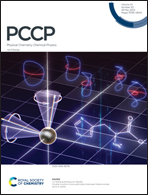7-membered-ring effect on fluorescence quantum yield: does metal-complexation-induced twisting-inhibition of an amino GFP chromophore derivative enhance fluorescence?†
Abstract
To investigate two aspects, namely, (1) the 7-membered-ring effect on fluorescence quantum yield and (2) whether metal-complexation-induced twisting-inhibition of an amino green fluorescent protein (GFP) chromophore derivative is bound to enhance fluorescence, a novel GFP-chromophore-based triamine ligand, (Z)-o-PABDI, is designed and synthesized. Before complexation with metal ions, the S1 excited state of (Z)-o-PABDI undergoes τ-torsion relaxation (Z/E photoisomerization) with a Z/E photoisomerization quantum yield of 0.28, forming both ground-state (Z)- and (E)-o-PABDI isomers. Since (E)-o-PABDI is less stable than (Z)-o-PABDI, it is thermo-isomerized back to (Z)-o-PABDI at room temperature in acetonitrile with a first-order rate constant of (1.366 ± 0.082) × 10−6 s−1. After complexation with a Zn2+ ion, (Z)-o-PABDI as a tridentate ligand forms a 1 : 1 complex with the Zn2+ ion in acetonitrile and in the solid state, resulting in complete inhibition of the φ-torsion and τ-torsion relaxations, which does not enhance fluorescence but causes fluorescence quenching. (Z)-o-PABDI also forms complexes with other first-row transition metal ions Mn2+, Fe3+, Co2+, Ni2+ and Cu2+, generating almost the same fluorescence quenching effect. By comparison with the 2/Zn2+ complex, in which a 6-membered ring of Zn2+-complexation enhances fluorescence significantly (a positive 6-membered-ring effect on fluorescence quantum yield), we find that the flexible 7-membered rings of the (Z)-o-PABDI/Mn+ complexes trigger their S1 excited states to relax through internal conversion at a rate much faster than fluorescence (a negative 7-membered-ring effect on fluorescence quantum yield), leading to fluorescence quenching regardless of the type of transition metal that complexes with (Z)-o-PABDI.



 Please wait while we load your content...
Please wait while we load your content...